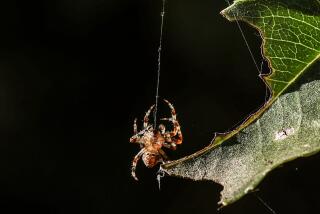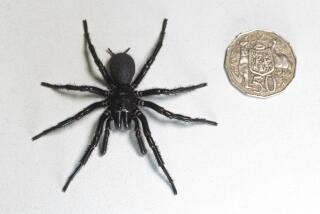Spiders
Whether they are sneaking around dusty attics, swimming underwater or roaming the Earth from Amazon jungles and the snows of Mount Everest, spiders play an important role in the web of life. These creepy-crawly creatures eat harmful insects, either through hunting or by trapping them through amazingly crafted webs. Find out the facts about these ingenious, useful and sometimes dangerous creatures through these direct links on the Times’ Launch Point Web site: http://161.35.110.226/launchpoint/.
Here are the best sites for getting your schoolwork done or for just having fun.
Level 1
Student Friendly Webquests: Spiders: What do spiders eat? Why don’t spiders stick to their own webs? This guided spider tour even includes a video of a tarantula.
https://www.angelfire.com/tx4/lessons/spider3.html
Fascinating World of Spiders: Engineers have discovered that it takes more energy to break a single strand of spider silk than it takes to break high-tensile steel. Learn about careers working with spiders as well as many interesting facts about spiders and their webs.
https://www.eng.iastate.edu/explorer/spiders/ Explorer%20Page_files/Explorer%20Page.htm
Spiders: Some ways to identify spiders from other insects is that spiders always have eight legs and they do not have wings or antennae. This site assembled by some Australian fifth-graders offers extensive information on spider anatomy, habitat and first aid as well as spider facts, songs and stories.
https://www.powerup.com.au/~glen/spider.htm
Level 2
Spider: A-Z Science: Spiders are important because they eat harmful insects such as grasshoppers that eat crops and mosquitoes, which carry diseases. Learn about various types of spiders and how they live in many diverse environments.
https://school.discovery.com/homeworkhelp/ worldbook/atozscience/s/524980.html
Discovery Online: Spiders: Find out how to identify spider families and read field reports by arachnologists, scientists who study spiders.
https://www.discovery.com/exp/spiders/spiders.html
PEERS Spider Identification Database: Use this online database to identify spiders by selecting specific characteristics such as behavior and habitat.
https://140.211.62.101/catalog/
Level 3
World of Spiders: With more than 35,000 species identified, spiders can range in size from smaller than a pinhead to almost 10 inches wide. Photos and stories about spiders from all over the world.
https://www.thesnake.org/spiders.html
Spiders of North-West Europe: How do spiders construct a wheel web? Find out through this site that features many resources includes diagrams, photos and a spider glossary.
https://www.xs4all.nl/~ednieuw/Spiders/spidhome.htm
Scientific American Frontiers: Spiders: Compare the characteristics and behavior of spiders from Denmark, Australia and Arizona and find out how virtual reality can be used to cure arachnophobia, or the fear of spiders.
https://www.pbs.org/saf/transcripts/transcript905.htm#7
*
Launch Point is produced by the UC Irvine department of education, which reviews each site for appropriateness and quality. Even so, parents should supervise their children’s use of the Internet. This column was designed by Nicole Bucciarelli, Patrick Berry, Ida Wong and Anna Manring.
EXPLORER’S QUEST
The answer to this Internet quiz can be found in the sites at right.
What are five items that spiders can weave with their silk?
CLUE: See Fascinating World of Spiders
Find What You Need to Know: Have a project on California history? Need help doing a math problem? Launch Point covers more than 150 topics for getting your schoolwork done. Go to http://161.35.110.226/launchpoint/ for the full list of subjects and direct links to the best Internet sites.
Answer to last week’s Quest: Paper can be recycled only four to six times because the fibers wear out and lose their papermaking qualities.


